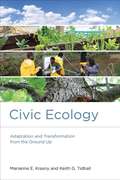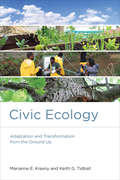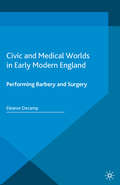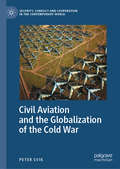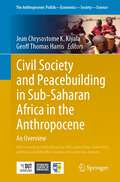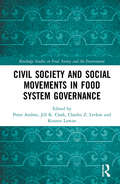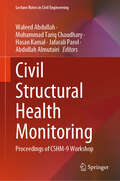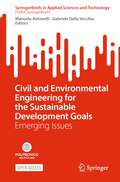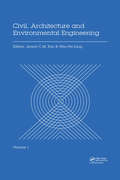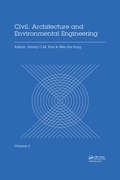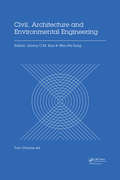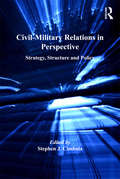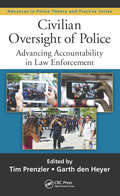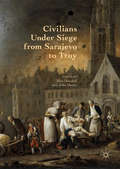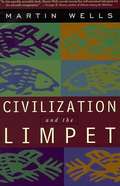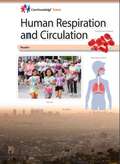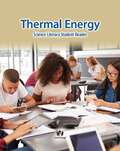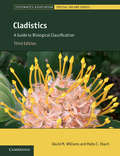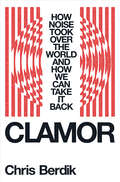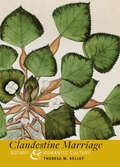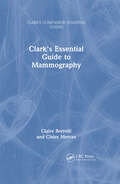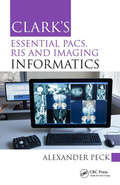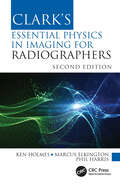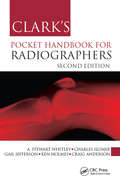- Table View
- List View
Civic Ecology
by Marianne E. Krasny Keith G. TidballIn communities across the country and around the world, people are coming together to rebuild and restore local environments that have been affected by crisis or disaster. In New Orleans after Katrina, in New York after Sandy, in Soweto after apartheid, and in any number of postindustrial, depopulated cities, people work together to restore nature, renew communities, and heal themselves. In Civic Ecology, Marianne Krasny and Keith Tidball offer stories of this emerging grassroots environmental stewardship, along with an interdisciplinary framework for understanding and studying it as a growing international phenomenon. Krasny and Tidball draw on research in social capital and collective efficacy, ecosystem services, social learning, governance, social-ecological systems, and other findings in the social and ecological sciences to investigate how people, practices, and communities interact. Along the way, they chronicle local environmental stewards who have undertaken such tasks as beautifying blocks in the Bronx, clearing trash from the Iranian countryside, and working with traumatized veterans to conserve nature and recreate community. Krasny and Tidball argue that humans' innate love of nature and attachment to place compels them to restore nature and places that are threatened, destroyed, or lost. At the same time, they report, nature and community exert a healing and restorative power on their stewards.
Civic Ecology: Adaptation and Transformation from the Ground Up (Urban and Industrial Environments)
by Marianne E. Krasny Keith G. TidballStories of environmental stewardship in communities from New Orleans to Soweto accompany an interdisciplinary framework for understanding civic ecology as a global phenomenon.In communities across the country and around the world, people are coming together to rebuild and restore local environments that have been affected by crisis or disaster. In New Orleans after Katrina, in New York after Sandy, in Soweto after apartheid, and in any number of postindustrial, depopulated cities, people work together to restore nature, renew communities, and heal themselves. In Civic Ecology, Marianne Krasny and Keith Tidball offer stories of this emerging grassroots environmental stewardship, along with an interdisciplinary framework for understanding and studying it as a growing international phenomenon. Krasny and Tidball draw on research in social capital and collective efficacy, ecosystem services, social learning, governance, social-ecological systems, and other findings in the social and ecological sciences to investigate how people, practices, and communities interact. Along the way, they chronicle local environmental stewards who have undertaken such tasks as beautifying blocks in the Bronx, clearing trash from the Iranian countryside, and working with traumatized veterans to conserve nature and recreate community. Krasny and Tidball argue that humans' innate love of nature and attachment to place compels them to restore nature and places that are threatened, destroyed, or lost. At the same time, they report, nature and community exert a healing and restorative power on their stewards.
Civic and Medical Worlds in Early Modern England: Performing Barbery and Surgery (Early Modern Literature in History)
by E. DecampThrough its rich foray into popular literary culture and medical history, this book investigates representations of regular and irregular medical practice in early modern England. Focusing on the prolific figures of the barber, surgeon and barber-surgeon, the author explores what it meant to the early modern population for a group of practitioners to be associated with both the trade guilds and an emerging professional medical world. The book uncovers the differences and cross-pollinations between barbers and surgeons' practices which play out across the literature: we learn not only about their cultural, civic, medical and occupational histories but also about how we should interpret patterns in language, name choice, performance, materiality, acoustics and semiology in the period. The investigations prompt new readings of Shakespeare, Jonson, Middleton and Beaumont, among others. And with chapters delving into early modern representations of medical instruments, hairiness, bloodletting procedures, waxy or infected ears, wart removals and skeletons, readers will find much of the contribution of this book is in its detail, which brings its subject to life.
Civil Aviation and the Globalization of the Cold War (Security, Conflict and Cooperation in the Contemporary World)
by Peter SvikThis book focuses on the highly complex and intertwined relationship between civil aviation, technological globalization and Cold War politics. It explores how the advancement of Soviet civil aircraft engineering during the 1950s technically triggered the globalization of the Cold War. The study also shows how the processes of technological standardization facilitated transfers of technology and knowledge across the Iron Curtain and how East-West as well as East-South connections evolved. It uncovers the motives and reasons for this transfer of knowledge and expertise, and aims to identify the specific roles played by states, international organizations and interpersonal networks. By taking a global approach to this history, the book advances ongoing debates in the field. It reassesses Europe’s role in the Cold War, pointing out the substantial differences in how Western Europe and the United States viewed the Communist world. This book will be of interest to scholars of international history, the history of technology and Cold War history.
Civil Society and Peacebuilding in Sub-Saharan Africa in the Anthropocene: An Overview (The Anthropocene: Politik—Economics—Society—Science #34)
by Jean Chrysostome K. Kiyala Geoff Thomas HarrisThis book examines civil society's peacebuilding role in sub-Saharan Africa in the contextof climate change and the pursuit of environmental peace and justice in the Anthropocene.Five main research themes emerge from its 20 chapters:· The roles of environmental peacemaking, environmental justice, ecologicaleducation and eco-ethics in helping to mitigate the impacts of climate change· Peacebuilding by CSOs after violent conflicts, with particular reference toaccountability, reconciliation and healing· CSO involvement in democratic processes and political transition after violentconflicts· Relationships between local CSOs and their foreign funders and the interactionsbetween CSOs and the African Union's peace and security architecture.· The particular role of faith-based CSOsThe book underlines the centrality of dialogue to African peacebuilding and the indigenouswisdom and philosophies on which it is based. Such wisdom will be a key resource inconfronting the existential challenges of the Anthropocene.The book will be a significant resource for researchers, academics and policymakersconcerned with the challenge of climate change, its interactions with armed conflict and thepeacebuilding role of CSOs.· This pathbreaking book shows why peacebuilding analysis and efforts need to beurgently re-oriented towards the existential challenges of environmental peace andjustice.· It explains the emerging conceptual frameworks which are needed for this new role.· It explains the critical role that CSOs - local and international - will play inimplementing this new peacebuilding approach, with particular reference to sub-Saharan Africa.
Civil Society and Social Movements in Food System Governance (Routledge Studies in Food, Society and the Environment)
by Charles Z. Levkoe Kristen Lowitt Peter Andrée Jill K. ClarkThis book offers insights into the governance of contemporary food systems and their ongoing transformation by social movements. As global food systems face multiple threats and challenges there is an opportunity for social movements and civil society to play a more active role in building social justice and ecological sustainability. Drawing on case studies from Canada, the United States, Europe and New Zealand, this edited collection showcases promising ways forward for civil society actors to engage in governance. The authors address topics including: the variety of forms that governance engagement takes from multi-stakeholderism to co-governance to polycentrism/self-governance; the values and power dynamics that underpin these different types of governance processes; effective approaches for achieving desired values and goals; and, the broader relationships and networks that may be activated to support change. By examining and comparing a variety of governance innovations, at a range of scales, the book offers insights for those considering contemporary food systems and their ongoing transformation. It is suitable for food studies students and researchers within geography, environmental studies, anthropology, policy studies, planning, health sciences and sociology, and will also be of interest to policy makers and civil society organisations with a focus on food systems.
Civil Structural Health Monitoring: Proceedings of CSHM-9 Workshop (Lecture Notes in Civil Engineering #516)
by Waleed Abdullah Muhammad Tariq Chaudhary Hasan Kamal Jafarali Parol Abdullah AlmutairiThis book gathers the latest advances and innovations in the field of structural health monitoring, as presented at the 9th Civil Structural Health Monitoring Workshop (CSHM-9), held in Kuwait on February 12–14, 2024. It discusses emerging challenges in civil SHM and more broadly in the fields of smart materials and intelligent systems for civil engineering applications. The contributions cover a diverse range of topics, including applications of SHM to civil structures and infrastructures, innovative sensing solutions for SHM, data-driven damage detection techniques, nonlinear systems and analysis techniques, influence of environmental and operational conditions, aging structures and infrastructures in hazardous environments, and SHM in earthquake prone regions. Selected by means of a rigorous peer-review process, they will spur novel research directions and foster future multidisciplinary collaborations.
Civil and Environmental Engineering for the Sustainable Development Goals: Emerging Issues (SpringerBriefs in Applied Sciences and Technology)
by Manuela Antonelli Gabriele Della VecchiaThis open access volume collects emerging issues in Environmental and Civil Engineering, originating from outstanding doctoral dissertations discussed at Politecnico di Milano in 2021. The advanced innovative insights provided are presented with reference to the relevant sustainable development goals (SDGs), hoping that scientists, technicians and decision makers will find them as a valid support to face future sustainability challenges. Indeed, the fast evolution of our society often falls short in properly taking into consideration its relationship with the environment, which is not only the primary source of any resource and the sink of all the wastes we generate throughout our activities, but also the cause of most of the loading and constraints applied to structures and infrastructures. The lack of a proper consideration of the relationship between the needs of both the society and the environment may lead to strong disequilibria, generating a large amount of threats for a robust, resilient and continuous development. In this perspective, the SDGs set by the United Nations represent the criteria to revise our development model, towards the ability to conjugate different needs to build a safe relation between anthropic activities and the environment. Civil and Environmental Engineering plays a relevant role in providing methods, approaches, risk and impact assessments, as well as technologies, to fulfil the SDGs. Research in these fields may in fact provide technical knowledge and tools to support decision makers and technicians in: (i) planning mitigation and adaptation actions to climate change, extreme weather, earthquakes, drought, flooding and other natural disasters; (ii) designing efficient and sustainable strategies for resources exploitation, minimizing the impact and the unequal distributions; (iii) increasing the safety of structures and infrastructures under exceptional loadings and against the deterioration due to their lifecycle; (iv) adopting a holistic risk management approach and appropriate technologies to reduce pollution and environment deterioration, which increase vulnerability; (v) providing a safe drinking water and sanitation system to protect human health.
Civil, Architecture and Environmental Engineering Volume 1: Proceedings of the International Conference ICCAE, Taipei, Taiwan, November 4-6, 2016
by Jimmy C.M. Kao Wen-Pei SungThe 2016 International Conference on Civil, Architecture and Environmental Engineering (ICCAE 2016), November 4-6, 2016, Taipei, Taiwan, is organized by China University of Technology and Taiwan Society of Construction Engineers, aimed to bring together professors, researchers, scholars and industrial pioneers from all over the world. ICCAE 2016 is the premier forum for the presentation and exchange of experience, progress and research results in the field of theoretical and industrial experience. The conference consists of contributions promoting the exchange of ideas between researchers and educators all over the world.
Civil, Architecture and Environmental Engineering Volume 2: Proceedings of the International Conference ICCAE, Taipei, Taiwan, November 4-6, 2016
by Jimmy C.M. Kao Wen-Pei SungThe 2016 International Conference on Civil, Architecture and Environmental Engineering (ICCAE 2016), November 4-6, 2016, Taipei, Taiwan, is organized by China University of Technology and Taiwan Society of Construction Engineers, aimed to bring together professors, researchers, scholars and industrial pioneers from all over the world. ICCAE 2016 is the premier forum for the presentation and exchange of experience, progress and research results in the field of theoretical and industrial experience. The conference consists of contributions promoting the exchange of ideas between researchers and educators all over the world.
Civil, Architecture and Environmental Engineering: Proceedings of the International Conference ICCAE, Taipei, Taiwan, November 4-6, 2016
by Jimmy C.M. Kao Wen-Pei SungThis two-volume work contains the papers presented at the 2016 International Conference on Civil, Architecture and Environmental Engineering (ICCAE 2016) that was held on 4-6 November 2016 in Taipei, Taiwan. The meeting was organized by China University of Technology and Taiwan Society of Construction Engineers and brought together professors, researchers, scholars and industrial pioneers from all over the world. ICCAE 2016 is an important forum for the presentation of new research developments, exchange of ideas and experience and covers the following subject areas: Structural Science & Architecture Engineering, Building Materials & Materials Science, Construction Equipment & Mechanical Science, Environmental Science & Environmental Engineering, Computer Simulation & Computer and Electrical Engineering.
Civil-Military Relations in Perspective: Strategy, Structure and Policy
by Stephen J. CimbalaThe topic of civil-military relations has high significance for academics, for policy makers, for military commanders, and for serious students of public policy in democratic and other societies. The post-Cold War and post-9-11 worlds have thrown up traditional as well as new challenges to the effective management of armed forces and defense establishments. Further, the present century has seen a rising arc in the use of armed violence on the part of non-state actors, including terrorists, to considerable political effect. Civil-military relations in the United States, and their implications for US and allied security policies, is the focus of most discussions in this volume, but other contributions emphasize the comparative and cross-national dimensions of the relationship between the use or threat of force and public policy. Authors contributing to this study examine a wide range of issues, including: the contrast between theory and practice in civil-military relations; the role perceptions of military professionals across generations; the character of civil-military relations in authoritarian or other democratically-challenged political systems; the usefulness of business models in military management; the attributes of civil-military relations during unconventional conflicts; the experience of the all-volunteer force and its meaning for US civil-military relations; and other topics. Contributors include civilian academic and policy analysts as well as military officers with considerable academic expertise and experience with the subject matter at hand.
Civilian Oversight of Police: Advancing Accountability in Law Enforcement (Advances in Police Theory and Practice)
by Tim Prenzler Garth Den HeyerExploring the complex and controversial topic of civilian oversight of police, this book analyzes the issues and debates entailed by civilian oversight by using worldwide perspectives, in-depth case studies, and a wealth of survey data. It integrates and summarizes decades of research from many locations around the globe to present a best practices model for managing police conduct. It also describes the impact of oversight agencies on police policy, including innovative means by which agencies can work with police departments to improve police conduct.
Civilians Under Siege from Sarajevo to Troy
by John Horne Alex DowdallThis edited volume analyses siege warfare as a discrete type of military engagement, in the face of which civilians are particularly vulnerable. Siege warfare is a form of combat that has usually had devastating effects on civilian populations. From the near-contemporary Siege of Sarajevo to the real and mythical sieges of the ancient Mediterranean, this has been a recurring type of military engagement which, through bombardment, starvation, disease and massacre, places non-combatants at the heart of battle. To date, however, there has been little recognition of the effects of siege warfare on civilians. This edited volume addresses this gap. Using a distinctive regressive method, it begins with the present and works backwards, avoiding teleological interpretations that suggest the targeting of civilians in war is a modern phenomenon. Its contributors interrogate civilians' roles during sieges, both as victims and active participants; the laws and customs of siege warfare; its place in historical memory, and the ways civilian survivors have dealt with trauma. Its scope and content ensure that the collection is essential reading for all those interested in the place of civilians in war. Chapter 2 of this book is available open access under a CC BY 4. 0 license at link. springer. com
Civilization and the Limpet
by Martin WellsIn 25 non-technical essays conceived during an ocean voyage from England to the Mediterranean, Wells (marine biology, Cambridge U.) reflects on the diversity and tenacity of life in the sea. Besides the seemingly unintelligent limpet always returning to the exact same spot, he describes sea urchins making survival decisions, so called deserted islands teeming with animal life, and whales diving deep and surface without getting the bends. He includes an index but no bibliography. Annotation c. Book News, Inc., Portland, OR (booknews.com)
Cksci G4 U6 Human Respiration And Circulation: Student Book
by Core Knowledge FoundationCksci G4 U6 Human Respiration And Circulation
Cksci G6u2 Thermal Energy: Student Book
by Core Knowledge FoundationScience Literacy Student Reader
Cladistics: A Guide to Biological Classification (Systematics Association Special Volume Series #88)
by Malte C. Ebach David M. WilliamsThis new edition of a foundational text presents a contemporary review of cladistics, as applied to biological classification. It provides a comprehensive account of the past fifty years of discussion on the relationship between classification, phylogeny and evolution. It covers cladistics in the era of molecular data, detailing new advances and ideas that have emerged over the last twenty-five years. Written in an accessible style by internationally renowned authors in the field, readers are straightforwardly guided through fundamental principles and terminology. Simple worked examples and easy-to-understand diagrams also help readers navigate complex problems that have perplexed scientists for centuries. This practical guide is an essential addition for advanced undergraduates, postgraduates and researchers in taxonomy, systematics, comparative biology, evolutionary biology and molecular biology.
Clamor: How Noise Took Over the World - and How We Can Take It Back
by Chris BerdikA May 2025 Next Big Idea Club Must-Read Book An eye- (and ear-) opening investigation into how our ever-noisier world affects our health, our well-being, and our planet. Early-morning jackhammering from construction down the block. The dull roar of jets flying overhead. Your office mates’ phone conversations. We are surrounded by noise, but it is a problem many of us shrug off once the immediate annoyance passes. Yet as gifted science journalist Chris Berdik explains in Clamor, noise can have serious health effects, disrupting our sleep, ratcheting up our stress, and destroying our concentration. As he argues, it is one of the most pervasive, yet underacknowledged, pollutants in our daily lives—one that we neglect, both individually and systemically, at our peril Drawing on extensive research and original reporting, Berdik shows how a too-limited understanding of noise, focused on loud sounds and decibel counts, has undermined a century of noise-control efforts and obscured the full toll noise exacts on us and the environment. Chronic exposure to noise that falls below decibel-based thresholds—sometimes even below our conscious awareness—is linked to spikes in the risk of heart disease and other serious health ailments that contribute to premature death. Noisy classrooms hinder developing minds and delay cognitive milestones. In forests and in the depths of the ocean, a cacophony of manmade sound disrupts the natural soundscape, threatening animals’ capacity to communicate, hunt, and flee predators. Yet in the battle against noise, sound doesn’t have to be our enemy: Berdik introduces us to the researchers, rock stars, architects, and many others who are finding surprising ways to make our world sound not only less bad, but better. Rising above the ever-increasing racket, Clamor is an urgent—and ultimately inspiring—call to finally take noise seriously and harness sound’s great potential.
Clandestine Marriage: Botany and Romantic Culture
by Theresa M. KelleyBotany in the romantic era played a role in debates about life, nature, and knowledge, as evidenced in this ambitious, beautifully illustrated study.Winner, 2012 British Society for Literature and Science Book PrizeRomanticism was a cultural and intellectual movement characterized by discovery, revolution, and the poetic as well as by the philosophical relationship between people and nature. Botany sits at the intersection where romantic scientific and literary discourses meet. Clandestine Marriage explores the meaning and methods of how plants were represented and reproduced in scientific, literary, artistic, and material cultures of the period. Theresa M. Kelley synthesizes romantic debates about taxonomy and morphology, the contemporary interest in books and magazines devoted to plant study and images, and writings by such authors as Mary Wollstonecraft and Anna Letitia Barbauld. Period botanical paintings of flowers are reproduced in vibrant color, bringing her argument and the romantics' passion for plants to life.In addition to exploring botanic thought and practice in the context of British romanticism, Kelley also looks to the German philosophical traditions of Kant, Hegel, and Goethe and to Charles Darwin’s reflections on orchids and plant pollination. Her interdisciplinary approach allows a deeper understanding of a time when exploration of the natural world was a culture-wide enchantment.
Clang! Ernst Chladni's Sound Experiments: Ernst Chladni's Sound Experiments (Moments In Science Ser. #Vol. 2)
by Darcy PattisonThis elementary science picture book dramatizes the exciting meeting between a German scientist and French Emperor Napoleon Bonaparte. Like Bill Nye, the Science Guy today, Chladni popularized science. But during his work as an entertainer, he struggled to find the time and finances do actual research. This story provides a glimpse at the life of Ernst Chladni, the Father of Acoustics. It's an amazing example of how scientists collaborate internationally. The story is based on Chladni's own description of the event.
Clark's Essential Guide to Mammography (Clark's Companion Essential Guides)
by Claire Mercer Claire BorrelliThis easy-to-understand pocketbook in the highly respected Clark’s stable of imaging texts is an invaluable tool and training aid, providing essential information for mammographic positioning, technique and interpretation for mammography practitioners at all levels.Adopting a systematic and structured approach facilitating rapid reference in the clinical setting, the book covers general principles and all routine mammographic projections, including additional and adapted projections covered in a separate section, and is highly illustrated with clear explanatory line diagrams and imaging photographs.Clark’s Essential Guide to Mammography is ideal as an educational tool for trainee mammographers, trainee assistant and associate apprenticeship mammographers, mammography training teams and universities delivering mammography education and a convenient clinical guide for practising mammographers, including assistant and associate apprenticeship mammographers.
Clark's Essential PACS, RIS and Imaging Informatics (Clark's Companion Essential Guides)
by Alexander PeckImaging informatics is a complex and historically rapidly changing field, knowledge of which is central to the practice of all imaging specialists. This convenient pocket guide provides the foundations of knowledge in informatics, allowing radiographers in training and in practice, assistant practitioners and other allied health professionals to understand, use and develop more efficient ways of imaging that will in turn deliver improved patient care.
Clark's Essential Physics in Imaging for Radiographers (Clark's Companion Essential Guides)
by Phil Harris Ken Holmes Marcus ElkingtonThe second edition of this easy-to-understand pocket guide remains an invaluable tool for students, assistant practitioners and radiographers. Providing an accessible introduction to the subject in a reader-friendly format, it includes diagrams and photographs to support the text. Each chapter provides clear learning objectives and a series of MCQs to test reader assimilation of the material. The book opens with overviews of image production, basic mathematics and imaging physics, followed by detailed chapters on the physics relevant to producing diagnostic images using X-rays and digital technologies. The content has been updated throughout and includes a new chapter on CT imaging and additional material on radioactivity, dosimetry, and imaging display and manipulation.Clark’s Essential Physics in Imaging for Radiographers supports students in demonstrating an understanding of the fundamental definitions of physics applied to radiography … all you need to know to pass your exams!
Clark's Pocket Handbook for Radiographers (Clark's Companion Essential Guides)
by Ken Holmes Charles Sloane Gail Jefferson Craig Anderson A Stewart WhitleyDrawn from the bestselling Clark's Positioning in Radiography, this pocket handbook provides clear and practical advice to help radiographers in their day-to-day work. Designed for rapid reference, it covers how to position the patient and the central ray, describes the essential image characteristics and illustrates each radiographic projection with a positioning photograph and a radiograph.
